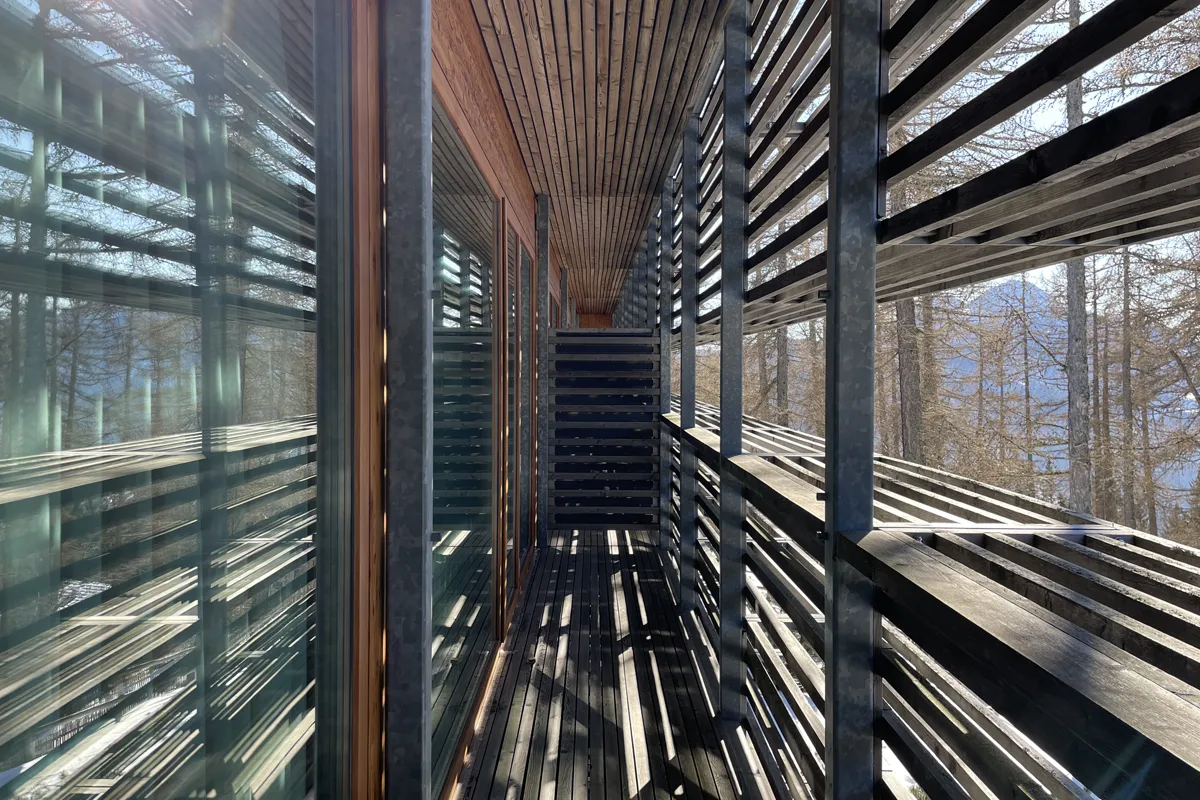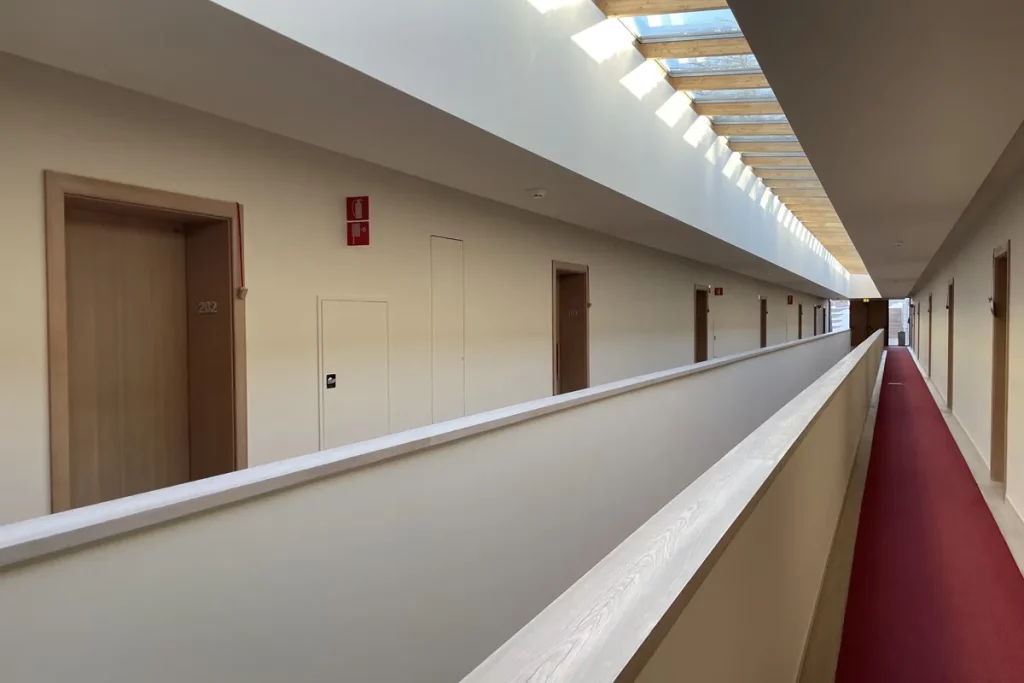Christina Biasi-von Berg explain the art of maintenance applied to Vigilius Mountain Resort – «Every detail is designed to last as long as possible» – according to the principle of Kintsugi
Don’t change, but fix and make it last: the importance of maintenance at Vigilius – with Christina Biasi-von Berg
According to interior designer Christina Biasi-von Berg, the best output at Vigilius Mountain Resort is its maintenance. Details would be designed with the intention of making it last as long as possible. When something breaks, it is preferred here to fix it rather than replace it. One can capture here the legacy of the farms, historic Tyrolean landowners who have carried on the tradition of repairing wooden houses for centuries.
This is an approach that winks at the Japanese philosophy of Kintsugi, the technique of repair with gold that sees scars and survival over time as valuable: «For us, luxury – meaning quiet luxury – is to be found in labor, in the time it takes to create things, and in their durability. The longer this time, the higher their quality. This is the mindset we have been pursuing for twenty years, and it also represents the future of Vigilius», Christina Biasi-von Berg starts recounting.
What is the Kintsugi philosophy? Meaning of the term and history of this Japanese practice
The history of kintsugi traces back to the late 15th century in Japan. The practice is said to have originated when the Japanese shogun Ashikaga Yoshimasa broke a favorite tea bowl and sent it to China for repair. Upon its return, the bowl was repaired using metal staples, which detracted from its appearance. Dissatisfied with the result, Japanese craftsmen sought a more aesthetic solution, leading to the development of kintsugi.
Kintsugi became popularized during the Muromachi period (14th to 16th centuries) in Japan, particularly among tea masters who valued simplicity, austerity, and wabi-sabi aesthetics. Wabi-sabi is a Japanese aesthetic philosophy that embraces imperfection, impermanence, and the beauty of natural processes.
The philosophy behind kintsugi aligns closely with the principles of wabi-sabi, emphasizing the beauty of imperfection and transience. Rather than discarding broken pottery, kintsugi artisans mend it using lacquer infused with precious metals, transforming it into a piece of art that celebrates its unique history.
Over time, kintsugi has evolved beyond its origins in pottery repair and has been embraced as a broader metaphor for resilience, acceptance, and the beauty of imperfection in life. Today, kintsugi continues to inspire artists, philosophers, and individuals seeking to find meaning and beauty in the challenges and hardships they encounter.
Vigilius Mountain Resort: eco-design hotel on Vigilio Mountain
Vigilius Mountain Resort is an eco-design hotel located on Vigiljoch Mountain in South Tyrol, near Merano. The hotel is located 1,500 meters above sea level and can only be reached by cable car. You go up to Lana-a small municipality in the province of Bolzano-and make the eight-minute slow ascent by cabin. No other vehicles are allowed, not even guests’ private cars, for which a special garage has been set up in the valley.
After the last run of the evening, there is no way to leave the mountain. You stay there, surrounded by woods, in an isolation that the owner, Ulrich Ladurner, envisioned as a mindful experience. A car-free site in which to live in the present moment.
The same harmony sought in the renovation and restyling project that breathed new life into an old mountain hotel that had fallen into disuse 20 years ago. Architect Matteo Thun was in charge of it, and he still oversees the hotel’s maintenance along with several collaborators. Among them is architect and interior designer Christina Biasi-von Berg, who told Lampoon Magazine about her twenty-year curatorship of what Thun calls «Neverland»: «Matteo and I have been caring for Vigilius together for twenty years, like a child».
Nature and craftsmanship at the heart of the Vigilius project
The philosophy behind the Vigilius renovation and restyling project finds expression in the Latin maxim adduced by Matteo Thun as a Manifesto of his vision: «Eco, not ego». A move beyond Cartesian-Newtonian anthropocentric thinking to a more ecological and holistic approach. According to Thun, there is a need to shift the focus from the individual to the individuality that comes from respecting the place where one lives and builds.
In the Vigilius, this approach is translated in the emphasis placed on craftsmanship and attention to the nature surrounding the hotel. A relationship, that between the natural environment and the man-made structure, that is not meant to be one of rupture, but one of continuity and dialogue. «Neverland», therefore, is a hotel that aims to build a symbiosis between man and nature through techniques and materials with reduced environmental impact.
Wood, clay, glass, linen, quartzite and roughness: the natural materials of Vigilius
«Synthesis» is the key word behind the Vigilius project. Synthesis between architecture and nature, as well as between the building’s exterior and interior. A dialogue made possible by the large windows, which make the surrounding forests and mountains ubiquitous companions of the guests’ stay, blurring the boundaries between inside and outside, between human and natural environment: «Design is always subordinate to nature, which is expressed here in all its power».
Also derived from the nature of the place are the main materials that were used for both the exterior and interior of the Vigilius. First and foremost, larch wood, a species of conifer that is widespread in South Tyrol. On the Salten Plateau near Bolzano, there is the largest larch meadow in Europe. The wood of this tree is durable, waterproof and environmentally friendly. Larch grows and spreads rapidly, so its use in carpentry and construction does not put it at risk of extinction.
The untreated wood is accompanied by clay and quartzite. Clay has been left exposed in several places, both outside and in the interiors. For example, in the rooms, a natural pressed clay fifth separates the sleeping area from the bathroom and acts as a climate regulator in every season. The warmth of wood and clay are mimicked by the widespread use of the color red.
The main element of the entrance hall, the lobby, part of the corridor and the swimming pool is silver quartzite. This is a basalt stone typical of South Tyrol, the natural roughness of which is enhanced in the Vigilius. An effect that is also mimicked by the linen textile furnishings. These give lightness and balance the solidity of the other materials.
Bioarchitecture: human commitment to the environment at Vigilius
At Vigilius, sustainability is not only synonymous with natural materials, but also and especially with human commitment to the environment. Or, in other words, bio architecture. From the design stage, it was decided to use wood chips, a biomass derived from wood, as fuel. This is purchased from the farmers who tend the forest, so it also fuels the local economy. The hotel’s system is designed to filter and optimize combustion so as to limit carbon dioxide emissions.
To reduce the facility’s energy needs in winter, an insulating roof reinforced by a layer of humus was built. For summer, on the other hand, sunshades, thermal accumulators and a ventilation system were installed to ensure internal air recirculation without creating drafts.
Digital detox and wellness at Spa Aquiléia with water from Monte San Vigilio
Il Vigilius invita i suoi ospiti a disconnettersi dai social, staccare gli occhi dagli schermi e riconnettersi al proprio io. Nell’hotel il 4G non prende, le camere non dispongono di TV e gli spazi comuni – come la spa e i ristoranti – sono digital free. Qui, viene richiesto agli ospiti di non utilizzare gli smartphone e di tenerli in modalità silenziosa. Nel resto della struttura, il wi-fi viene spento dalle 23 alle 7 di mattina per favorire il riposo. E, per chi volesse staccare completamente, c’è la possibilità di riporre i propri device all’interno di cassette di sicurezza.
La Spa Aquiléia comprende una piscina, una vasca idromassaggio, una sauna, un bagno turco, una sala relax, una sala di meditazione e un’area per fitness e meeting. L’acqua utilizzata al suo interno proviene dalla fonte del Bärenbad, ovvero direttamente dal Monte San Vigilio. La spa offre anche attività sportive, massaggi e trattamenti curativi per viso e corpo.
Restaurant 1500 and Stube Ida: natural raw materials and local tradition
The Vigilius houses two venues inside: Restaurant 1500 and Stube Ida. Completing the culinary offerings is breakfast, served with a view of the Dolomites. The lowest common denominator of all three is the use of natural raw materials, preferring seasonal ingredients and local products.
Enclosed in a minimalist-designed environment and directed by chef Filippo Zoncato, Restaurant 1500 aims to translate into flavors the emotions aroused by the mountain landscape it overlooks. The proposal is a gourmet cuisine that revisits local tradition in a modern key, contaminating it with national and international flavors.
More faithful to South Tyrolean tradition, on the other hand, is Stube Ida, again under Zoncato’s direction, which tells the story of the local population through its dishes. It also holds a piece of Vigilius history. Inside is, in fact, preserved the tiled stove that heated the old mountain hotel that preceded the resort. Outside, it has a solarium for those who wish to eat outdoors.
Vigilius Mountain Resort
Vigilius Mountain Resort is an eco-design hotel located one thousand five hundred meters above sea level on Vigiljoch Mountain in South Tyrol. It can be accessed only by cable car, leaving your car in the parking garage in the valley. The resort has thirty-five rooms, six suites, two restaurants, and a spa.




















